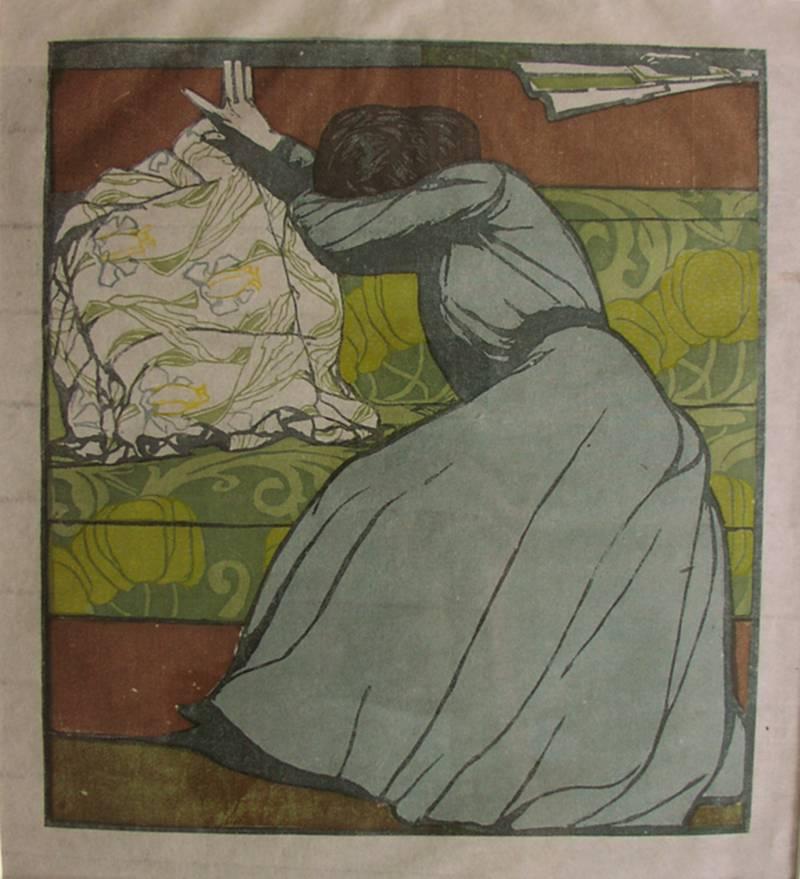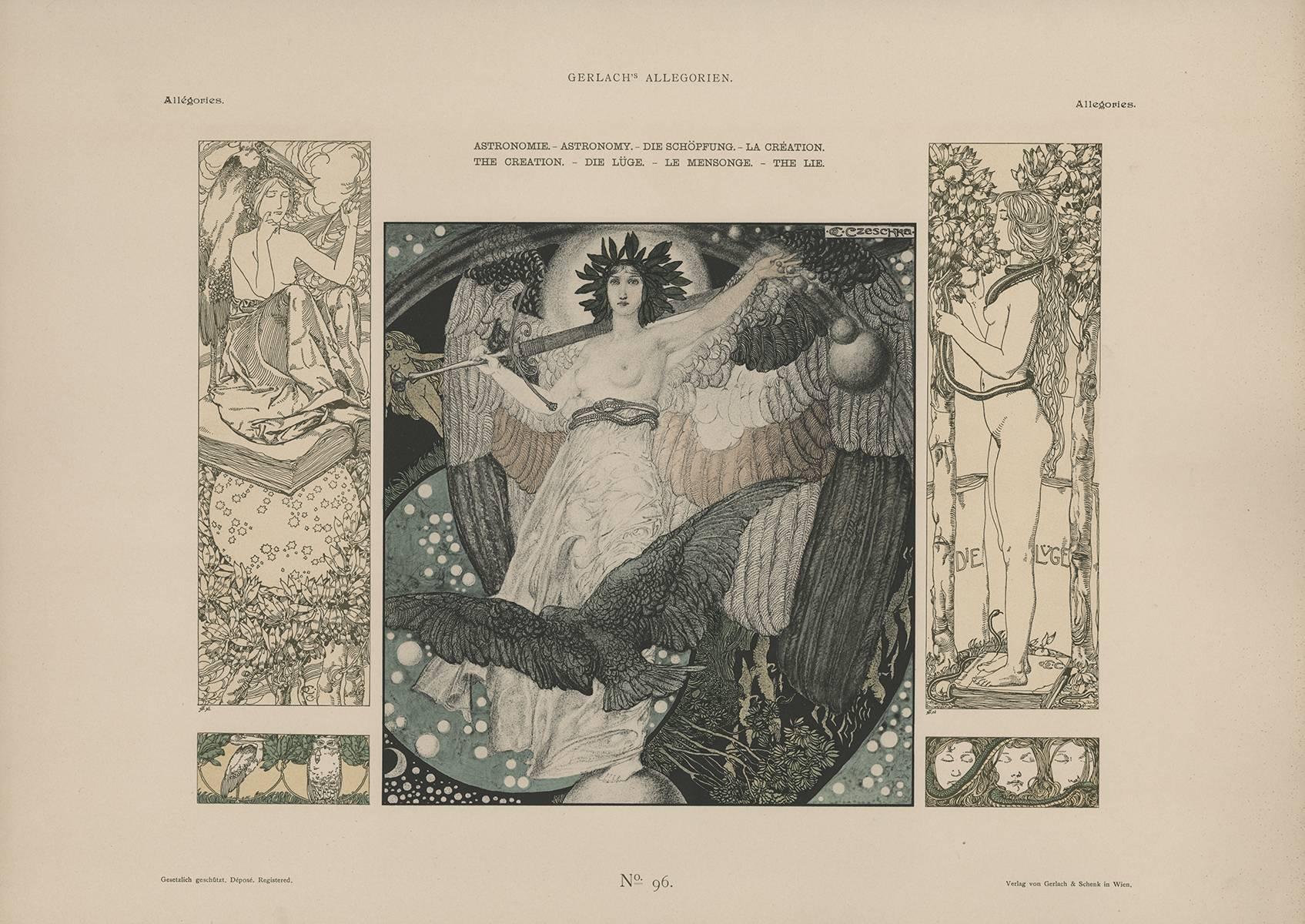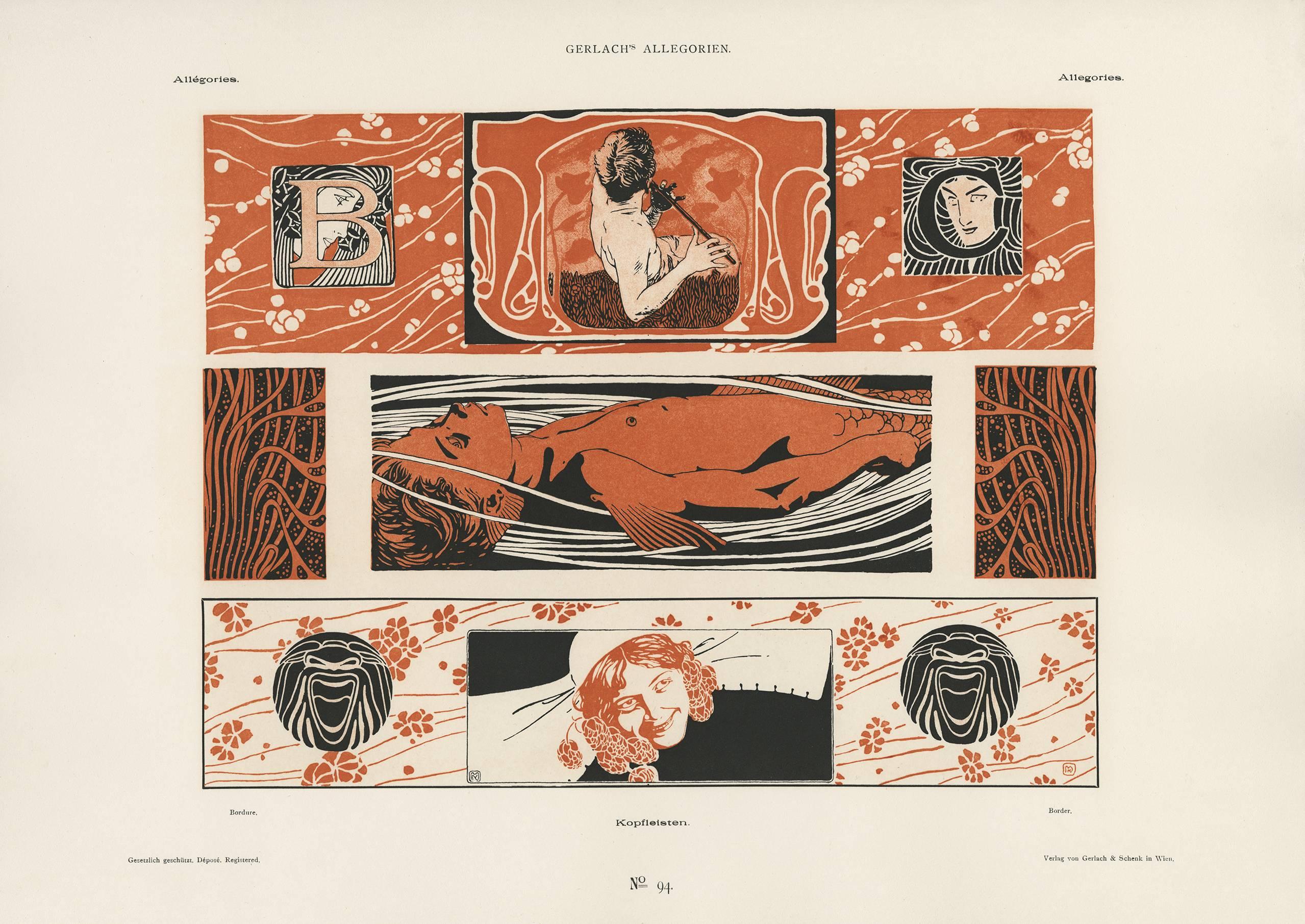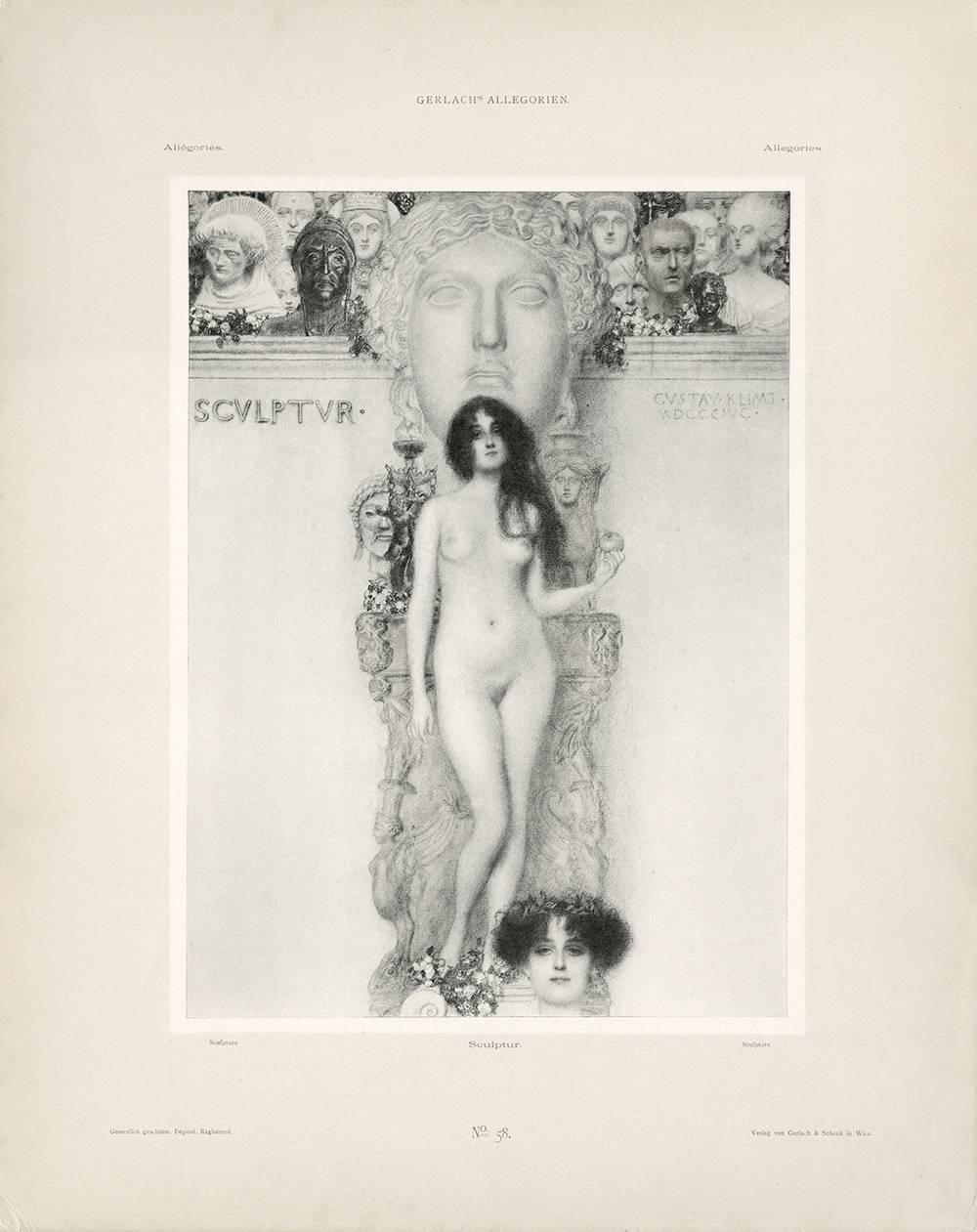Items Similar to Ottokar Mascha Folio, plate 18: "Shaw Oder Die Ironie Poster" by Egon Schiele
Want more images or videos?
Request additional images or videos from the seller
1 of 6
Egon SchieleOttokar Mascha Folio, plate 18: "Shaw Oder Die Ironie Poster" by Egon Schiele1915
1915
About the Item
after EGON SCHIELE (1890-1918) SHAW ODER DIE IRONIE POSTER, C. 1912, (In Mascha, no. 18) Schiele’s poster is an advertisement for a lecture to be given by Egon Friedell (1878-1938). A prominent member of Viennese artistic society, Friedell published works of historic and philosophical nature as well as theatrical criticism. He was the artistic director of Cabaret Fledermaus. Schiele’s bold, expressive line set against a red-hot ground creates a vivid fascial form of communication. The poster art form provided a platform for a new language of announcement. Schiele’s is a visual voice. His announcement is an audacious declaration. This sign, without context, is literally frozen in an instant; one must attend Friedell’s lecture to gain access to its content and meaning. Schiele uses gesture to grab one’s attention and deftly exploits the graphic medium to additionally punctuate this via the intense unprinted whites of the eyes and mouth to convey the nature of a live lecture: it is to be heard and seen.
OTTOKAR MASCHA (1852-1929), OSTERREICHISCHE PLAKATKUNST, 1915, J. Lowy Printer, in an edition of 230.
Austria’s foremost collector of poster prints, Ottokar Mascha amassed one of the largest international graphic art collections of the time. He was an active member in poster-collecting societies, and he gave generously to educational and other public institutions. In many cases, examples found in his collections were the sole survivors of an ephemeral medium whose delicate papers could not hold up over time to the damaging effects of animal glue, weathering, and other wear and tear from excessive handling. Mascha recognized that posters were not only cultural documents, but works of art. He devised ways to obtain pristine examples for his collection often through the police with whom posters needed to be submitted for approval prior to being hung in public. As Mascha explains in the forward and introduction of Plakatkunst, he saw a need in Austria for developing and promoting the poster as an artistic medium. His aims in publishing Plakatkunst were lofty; Mascha hoped to educate new and aspiring Austrian artists by exposing them to the possibilities the poster medium offered, and he hoped to develop a broader collector base through connoisseurship. His carefully selected examples of posters from his collection are archives of a nearly lost time. Preserved within this rare printed work are contextual links to Austria’s interconnected modern arts culture of which the Vienna Secession played a central role. Like the members of Vienna’s Secession, Mascha believed that modernity required a new definition of Art and that old hierarchical notions were out of touch. Creating a leveling force in the arts, where graphic and applied arts are valued equally as painting, sculpture and architecture, was an over-arching goal many were grappling to achieve at this time. He also shared the belief that, whether native or adoptive, there was, indeed, an Austrian sensibility whose zeitgeist he wanted to capture and preserve. For him, it was a question of accessibility. Today, bombarded as we are with digital and graphic images and their instant access we have literally at our fingertips, it is easy to forget that 100 years ago this was simply not the case. Plakatkunst, was, and is, an invaluable resource; it is a bold statement which continues to resound that the artistic merit of successful posters will stand the test of time.
- Creator:Egon Schiele (1890-1918, Austrian)
- Creation Year:1915
- Dimensions:Height: 15.25 in (38.74 cm)Width: 11.5 in (29.21 cm)
- Medium:
- Movement & Style:
- Period:
- Condition:
- Gallery Location:Chicago, IL
- Reference Number:1stDibs: LU467314042652

About the Seller
5.0
Gold Seller
These expertly vetted sellers are highly rated and consistently exceed customer expectations.
Established in 2013
1stDibs seller since 2016
82 sales on 1stDibs
Typical response time: 1 hour
- ShippingRetrieving quote...Ships From: Chicago, IL
- Return PolicyA return for this item may be initiated within 3 days of delivery.
More From This SellerView All
- Gerlach's Allegorien Plate #116: "Force, Thirst, Love" LithographBy Carl Otto CzeschkaLocated in Chicago, ILafter Carl Otto Czeschka, (1878-1960), Austrian A leading member of the Vienna Secession and later the Wiener Werkstätte (Viennese Workshop), Carl Otto Czeschka was a vital figu...Category
1890s Vienna Secession Figurative Prints
MaterialsLithograph
- Gerlach's Allegorien Plate #78: "Hunting" Lithograph by Carl Otto CzeschkaBy Carl Otto CzeschkaLocated in Chicago, ILafter Carl Otto Czeschka, (1878-1960), Austrian A leading member of the Vienna Secession and later the Wiener Werkstätte (Viennese Workshop), Carl Otto Czeschka was a vital figu...Category
1890s Vienna Secession Figurative Prints
MaterialsLithograph
- Gerlach's Allegorien Plate #98: "Poetry" Lithograph by Carl Otto CzeschkaBy Carl Otto CzeschkaLocated in Chicago, ILafter Carl Otto Czeschka, (1878-1960), Austrian A leading member of the Vienna Secession and later the Wiener Werkstätte (Viennese Workshop), Carl Otto Czeschka was a vital figu...Category
1890s Vienna Secession Figurative Prints
MaterialsLithograph
- Gerlach's Allegorien Folio, plate #58: "Sculpture" Lithograph, Gustav Klimt.By Gustav KlimtLocated in Chicago, ILAs an artist trained in the applied arts, Gustav Klimt valued all forms of art, including the graphic arts. This final design from 1896 for inclusion in Allegorien published by Gerlach & Schenk demonstrates respect for artistic precedent and for a wide range of media and technique. The publication was printed in an unknown number of copies. Klimt’s rendering in latin of the title, “SCVLPTVR.,” with three-dimensional effect on the wall, is a figurative allusion to this medium as well as a literal reference to Ancient Rome. By doing the same with his signature and date in roman numerals on the right hand side of the image, Klimt places himself, The Artist, firmly in this linear and legitimizing context of art history and as its modern standard-bearer. Playing on Classical mythology and the story of Pygmalion, in which a statue comes to life, Klimt presents his modern Venus holding an apple. Klimt’s Venus exhibits a curvilinear softness; there are no angles. Klimt deftly shows the possibilities in a graphic image to give life to dark, wavy hair and tenderness to swelling breasts and belly. To further emphasize the allegory of thriving modern art, he contrasts his Venus with the cold, hard ancient classical head whose eyes are vacuous and whose hair is but a stylized mass of curls. Klimt’s living Venus stands in front of the large bust and large classical pillar upon which is a sculpture of a Sphinx and a Greek Attic bust. As if a gallery to represent sculpture’s “best of” through the ages, the upper horizontal panel includes bust depictions in marble, cast metal and wood...Category
1890s Vienna Secession Figurative Prints
MaterialsLithograph
- Ottokar Mascha Folio, plate 8: "Poster for the 1st Vienna Secession Exhibition"By Gustav KlimtLocated in Chicago, ILAfter GUSTAV KLIMT (1862-1918) THESEUS UND MINOTAURUS, 1898, final design submission for poster advertising the first exhibition of the Vienna Secession, (In Mascha, no. 8) As a cele...Category
1910s Vienna Secession Figurative Prints
MaterialsLithograph
- Gerlach's Allegorien Plate #83: "Seasons" Lithograph by Carl Otto CzeschkaBy Carl Otto CzeschkaLocated in Chicago, ILafter Carl Otto Czeschka, (1878-1960), Austrian A leading member of the Vienna Secession and later the Wiener Werkstätte (Viennese Workshop), Carl Otto Czeschka was a vital f...Category
1890s Vienna Secession Figurative Prints
MaterialsLithograph
You May Also Like
- Der PolsterBy Max KurzweilLocated in New York, NYKurzweil, Maximilian. Der Polster, 1903. Color woodcut on japon. Included as an insert in Pan. Unsigned. Framed.11 1/4 x 10 1/4. 1 Ref: Hofstatter, p. 241; Pabst, p. 154. Maximillian Kurzweil was the co-founder of the Vienna Secession in 1897 and editor and illustrator of the influential Secessionist magazine Ver Sacrum...Category
Early 1900s Vienna Secession Figurative Prints
MaterialsLithograph
- Mädchen am Fenster. 1906-08.By Oskar KokoschkaLocated in New York, NYMädchen am Fenster. 1906-08. Color lithograph printed on smooth card stock. Full margins. Tipped into a later presentaion folder, signed by the artist in pencil, on the recto. Published by the Wiener Werkstätte, Vienna, with the printed postcard text on verso. Among Kokoschka's earliest prints were a series of 14 postcards, the current work and the following lot that he produced for the Wiener Werkstätte. Wingler/Welz 4. Oskar Kokoschka was an Austrian artist, poet and playwright best known for his intense expressionistic portraits...Category
Early 1900s Vienna Secession Figurative Prints
MaterialsLithograph
- Original Vintage Secession Poster celebrating the emperor's jubileeLocated in Zurich, CHOriginal Vintage Poster by the Austrian artist Ferdinand Ludwig Graf, a member of the Hagenbund. This Viennese artist association moved as soon a...Category
Early 1900s Vienna Secession Figurative Prints
MaterialsPaper
- Untitled WoodcutLocated in Wilton, CTOriginal hand-colored woodcut from a portfolio of Secessionist fashion illustrations. Signed in the lower right margin by the artist, Reni Schaschl (1895-1979), a talented member of...Category
1910s Vienna Secession Figurative Prints
MaterialsWoodcut
- FruhlingBy Josef Siccard-RedlLocated in New York, NYSiccard-Redl, Josef. Fruhling, Ca 1910. Color wood engraving, Signed and titled in pencil by the artist. Little is known of this artist other than he worked in Vienna during the ...Category
1910s Vienna Secession Figurative Prints
MaterialsEngraving
- Of Youth —after Gustav Mahler's 'The Song of the Earth'Located in Myrtle Beach, SCArthur Paunzen, 'Von der Jugend' (Of Youth) from the suite 'Song of the Earth', etching, aquatint, and drypoint, 1920. Signed and titled in pencil. Signed in the plate, lower left. A fine, richly-inked impression, on cream, wove Japan paper; the full sheet with margins (2 1/4 to 4 1/4 inches), in good condition. Image size 12 1/4 x 9 1/16 inches; sheet size 19 3/4 x 13 5/8 inches. Matted to museum standards, unframed. ABOUT THIS WORK Pauzen’s suite of six etchings 'Das Lied von der Erde' (The Song of the Earth), published in 1920, was inspired by Gustav Mahler...Category
1920s Vienna Secession Figurative Prints
MaterialsEtching, Drypoint, Aquatint




